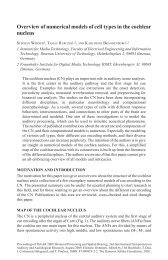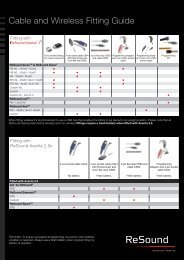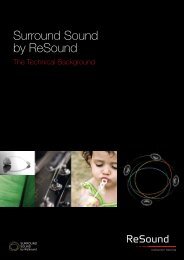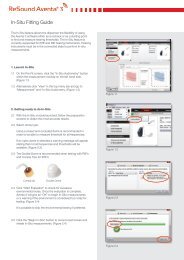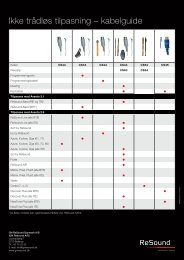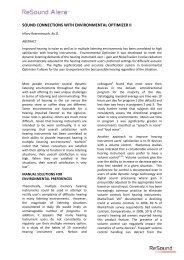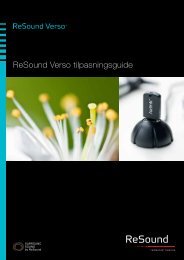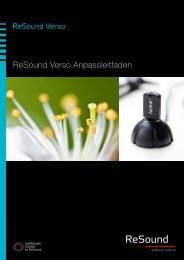White papers - GN ReSound
White papers - GN ReSound
White papers - GN ReSound
- No tags were found...
You also want an ePaper? Increase the reach of your titles
YUMPU automatically turns print PDFs into web optimized ePapers that Google loves.
The plan can be modified as needed to achieve maximumresults. As time passes on, and greater comfortusing these sounds has been achieved, patients canReferencesDavis, A., & Refaie, A. E. (2000). Epidemiology of tinnitus.In R. Tyler (Ed.), Tinnitus handbook (pp. 1-23).<strong>ReSound</strong> Alera TS TM : The role of wireless streaming in tinnitus managementMichael Piskosz, M.S., Board Certified in Audiologyapply these strategies to other troublesome situations(Henry et. al, 2008).One of the key elements of PTM is that the patientplays a very active role in identifying problems andcontributing input on ways to best manage these concerns.They take a very hands-on approach to anylifestyle changes and what sounds are best for themin helping them to alleviate their tinnitus. Having thecapability to wirelessly stream the sounds they feel aremost therapeutic and beneficial to their progress, putsthe user in control, which is consistent with the practicesof PTM.Most ear-level devices only offer white noise or proprietarysound files that may not always be preferred bya user, or be an appropriate sound source for a particulartinnitus management plan. By having the abilityto wirelessly stream different types of Environmental,Music or Speech sounds using <strong>ReSound</strong> Alera TS TM ,combined with the <strong>ReSound</strong> Unite TM Mini Microphone,users can truly customize and optimize the PTM managementprogram.ConclusionIt is important to note that there are multiple effectiveprograms to treat tinnitus. It is not the intentionof this paper to recommend one treatment programover another, but rather offer insight to the role soundplays in these different treatment programs, and howwireless streaming capabilities offers a unique flexibilitynever seen before. Note that the requirements of usingsound can vary greatly from treatment to treatment,but the ability to wirelessly stream different sound signals,allows you to maximize any treatment programto accommodate the unique needs of each individualtinnitus patient. <strong>ReSound</strong> Alera TS TM , combined withthe <strong>ReSound</strong> Unite TM Mini Microphone offers the flex-San Diego: Singular Publishing Group.Del Bo, L. Jastreboff, M., Parazzini, M., Ravazzani, P.(2008). Open Ear Amplification in Tinnitus Therapy: AnEfficiency Comparison with Custom Sound Generators.Henry JA, Rheinsburg B, Zaugg TL. Comparison ofcustom sounds for achieving tinnitus relief. J Am AcadAudiol 15(8):585-598, 2004.Henry JA, Zaugg TL, Myers P, Schechter MA. Usingtherapeutic sound with Progressive Audiologic TinnitusManagement. Trends in Amplification 12(3):185-206, 2008.Jastreboff, P. J., & Hazell, J.W.P. (1998). Treatment oftinnitus based on a neurophysiological model. In J. A.Vernon (Ed.), Tinnitus treatment and relief (pp. 201-217). Needham Heights, MA: Allyn & Bacon.Jastreboff, P.J. & Hazell, J.W.P. Tinnitus RetrainingTherapy: Implementing the Neurophysiological Model.Cambridge: Cambridge University Press, 2008.Searchfield GD, Cameron H, Irving S, KobayashiK. “Sound therapies and instrumentation for tinnitusmanagement.” New Zealand Medical Journal19 March 2010. Vol 123 No 1311; ISSN 1175 8716Page 112-125. URL: http://www.nzma.org.nz/journal/123-1311/4040/Tinnitus is the perception of sound in the absence ofan acoustic stimulus. It can vary greatly in its perceptualcharacteristics from person to person. Althoughthe exact mechanism of tinnitus causation is unknown,the origin of tinnitus activity is believed to liesomewhere within the auditory pathways (Henry et.al, 2008). Tinnitus is a concern for many people, andaffects approximately 10-15% of the overall population,with approximately 20% of that population sufferingfrom clinically treatable tinnitus (A. Davis & Refaie,2000; Jastreboff & Hazell, 1998). In addition, approximately80% of all tinnitus sufferers also have hearingloss. This shows the importance of having an effectivecombination unit, such as <strong>ReSound</strong> Alera TS TM , whichcan address both the hearing loss and tinnitus concernsof these individuals.There are different approaches of treating tinnitus, suchas medical management (in cases where the tinnituscan be addressed medically), educational counselingand sound therapy, each having a unique approach totinnitus management. Up until now, little research hasbeen published in regards to the effectiveness of hearinginstruments, tinnitus sound generators (TSGs) orcombination units for tinnitus management. This maybe partly to due to the fact that past ear-level technologyfor tinnitus management has been far from ideal,and this lack of flexibility has not addressed the uniqueneeds of each individual. For the most part, peoplestruggling with tinnitus have had to make due with eitherwhite noise generators, or preset music that maynot always be preferred by the user. Within the differenttinnitus management programs available, eachhas some distinct differences on how they incorporatesound into their management protocols, and pasttechnologies have not offered the flexibility to meet allthese requirements.Tinnitus management programsSound TherapyIn almost all tinnitus management programs, soundtherapy of some kind plays a significant role. Althoughcounseling alone can be used without sound therapy,it is often times not as effective as using a combinedapproach. Counseling-only type treatments aren’t intendedto change, or reduce the acoustic perceptionsof the tinnitus, but rather change the reactions to tinnitus,and the negative effects it may bring. This can bevery beneficial in regards to improving one’s reactionsto their tinnitus, but may not be enough for some tinnitussufferers.Sound therapy’s main intention is to divert one’s attentionaway from the tinnitus. By introducing sound intoone’s environment, we are able to minimize the contrastbetween the tinnitus and the background environment(Figure 1). For example, in a quiet room tinnitusis easily detected since there is a large discrepancybetween the loudness of the tinnitus and quietness ofthe environment. By enriching the environment withsound, we increase the loudness of the backgroundenvironment, therefore making the tinnitus less prominentand noticeable. Sound therapy can have immediateeffects, helping to reduce tinnitus audibility (e.g.masking/partial masking) which can also potentiallyresult in taming the underlying tinnitus. Sound stimulationmay also reverse or modify the abnormal corticalreorganization thought to be responsible for tinnitus(Searchfield et. al, 2010).LoudnessDecreased contrast betweentinnitus and noiseibility to accommodate any tinnitus management plan.In this paper, we will review some of the more wellestablishedtinnitus management programs, such asIncreased noise levelSound Therapy, Tinnitus Retraining Therapy (TRT) andProgressive Tinnitus Management (PTM), and howsound enrichment and wireless streaming using theM200586-GB 11.04 Rev.B<strong>ReSound</strong> Unite TM Mini Microphone can play a beneficialrole in achieving the goals of these tinnitus managementprograms.FrequencyFigure 1: Increasing the background noise level reduces the contrastbetween the tinnitus and the background sound level.
Many different instruments can be used for sound<strong>ReSound</strong> Alera TS TM is a combination hearing instru-However, when measuring these three sound signalsThe ANS, which is strongly connected to the limbicSome of the abiding principles of sound therapy withinThe five levels of management with PTM are as followstherapy. For example, with most ear-level devices, ament and tinnitus sound generator (TSG) that deli-in relation to decreasing tinnitus annoyance, musicsystem (emotional state) is responsible for automa-TRT are:(an individual can go through one level or all levels ac-broadband white noise generator is used, althoughvers a broadband white noise generator that can bewas preferred over white noise, with rain once againtic body functions such as heart rate, breathing andcording to their needs):some devices have proprietary signals that can befrequency-shaped according to the users preferencesbeing the most preferred (Searchfield et. al, 2010).hormonal levels. When put under extremes duress,• The external sound being used should not provokeused in place of, or in conjunction with the white noise.using low and high cut filters. In addition, it can bewhere a fast reaction is required (e.g. fight or flight),any negative reactions, irritate or annoy the user1. Triage - making the appropriate referrals accordingHowever, users are limited to the sound sources thatcombined with the <strong>ReSound</strong> Unite TM Mini MicrophoneSound therapy can be used in a variety of ways tothe ANS is automatically stimulated and prepares itself• It is important to maintain the perceptual characte-to the needs and concerns of the individualare available within these devices.(Figure 2) to wirelessly stream numerous sound sig-help enrich one’s acoustic environment. For example,for physical or mental activity. In regards to tinnitus,ristics of the tinnitus2. Audiologic Evaluation - relevant diagnostic testing,nals. This means that, literally, any sound source coulddepending on the time of day, or the environment oneinappropriate stress is put on these systems due to• Sounds should not draw attention, interfere withincluding hearing aids if appropriateAnother form of sound therapy is table top soundbe used for sound therapy. The limitations of only ha-is in, such as work versus home, a particular soundthe negative association of the tinnitus, which is oftenother important signals of interest, such as speech,3. Group Education - discussion of self-managementgenerators. Table top sound generators offer differentving a few restrictive sound sources to treat tinnitussource might be preferred over another. Wirelessdue to the fact that the person suffering doesn’t un-or affect daily activitiesstrategies within a group settingsound options, such as running creeks, birds chirping,have now been lifted. Users can upload any soundstreaming offers flexibility with sound therapy neverderstand what is happening to them, even though in• Sounds should not fully mask the tinnitus (the tin-4. Tinnitus Evaluation - provides an in-depth interviewsoothing ocean waves, as well as other nature-typesource to an MP3 player, connect it to the <strong>ReSound</strong>seen before, and allows for true customization of anymost cases, the tinnitus itself is harmless. When thesenitus signal should be audible), as this will prohibitto determine if further individualized managementsounds. Many table top sound generators are able toUnite TM Mini Microphone via a stereo plug, and havetinnitus management program, according to a user’ssystems are highly stimulated, a vicious cycle invol-habituation from occurring (you can’t habituate tois necessaryuse different sound cards, allowing one to change thethat sound source wirelessly streamed to their hea-needs and preferences.ving the auditory system, limbic system and ANS takessomething you can’t hear)5. Individualized Management - a customized tinnitussound signal at their convenience. Table top soundring instruments, allowing them to choose and useplace (Figure 3). One of the goals of TRT is to ‘break’management programgenerators can be used to enrich a quiet room withthe sound signals that are most beneficial and the-Tinnitus Retraining Therapy (TRT)this vicious cycle, and sound therapy is often times aTRT follows the rules that sounds used for sound the-sound, therefore diverting one’s attention away fromrapeutic to them. For example, one would not be li-Tinnitus Retraining Therapy (TRT) is a tinnitus manage-vital component of this treatment program.rapy should have stable continuous amplitudes, as thisIt is not the intention of this paper to discuss the fivethe tinnitus. They are often times used in the bedroomto help one sleep, but can be used to enrich multi-mited only to listening to white noise, but could streamother types of noise, such as pink, red, violet, blue,ment program that is based on the neurophysiologicalmodel of tinnitus, which educates the tinnitus patientChronic tinnitusis easier to habituate to than changing or fluctuatingsounds. Users should also have the ability to controllevels in great detail, but rather to help you better understandthe structure and flow of the PTM program.ple environments with sound. A limitation to table topsound generators are that they are not always convenientlyportable, nor discrete, like an ear-level device,and therefore are limited when and where they can beetc, which differ in their frequency shape, and couldprovide more benefit depending on the characteristicsof the tinnitus. In addition, other sound signals, suchas nature-like sounds, music or speech could also beto better understand the mechanisms involved withtinnitus, their reactions to tinnitus and ultimately helpsthem habituate to the tinnitus, from an emotional andperceptual perspective. Habituation is the process ofIncreasedattention totinnitusTinnitusManagementthe volume of the sound to optimize habituation, andalso provide some control, which may help in turn tomake the sound more non-threatening and therapeutic.In addition, broadband noise is often suggested,Educational counseling, including appropriate use ofsound, is provided during Level 3 - Group Educationand Level 5 - Individualized Management with PTM.used.used. It is important to remember that individual differencescan influence the effectiveness of specificsretraining the brain from conditioned responses. InTRT the habituation process turn the tinnitus from aBreakingtinnitusas it stimulates a wide range of neurons with the auditorysystem. And lastly, with open-fit instruments, en-At these points, there are 3 classifications of sounddiscussed in regards to tinnitus treatment.With the recent popularity of smart phones and thesound over others.negative signal back into a neutral signal, diminish-vironmental sounds can enter the ear naturally, helpingapplications that can be downloaded with them, aing any negative emotions towards the tinnitus. TRTto enrich the sound environment.• Soothing sounds - these sounds help produce anumber of tinnitus ‘apps’ are now available. Theseis the clinical implementation of the neurophysiologi-sense of relief from the stresses of the tinnitustinnitus applications typically offer different types ofnoise (i.e. white, pink, violet, etc.), as well as naturelikesounds that can be downloaded for a minimalcost and played over the external speaker or via headphones.Although the portability of the smart phone isquite convenient, if the user has a hearing loss, it is nottaken into account, and thus the sound therapy signalprovided by these phones may not be maximized.More commonly used in treating tinnitus are openfithearing instruments. Open-fit hearing instrumentshave been beneficial to a number of tinnitus sufferers,since the open ear canal allows for more naturalsound to enter, and therefore provides a form of ‘natural’sound therapy (Del Bo, et. al 2008). Hearing streetnoise, or people talking can enrich one’s environmentwith sound, therefore making the tinnitus harder to detect.Although many people benefit from using hearinginstruments alone for tinnitus management, there area number of people where amplification alone is notFigure 2: The <strong>ReSound</strong> Unite TM Mini MicrophoneSounds used for sound therapy can vary in their temporal,spectral and emotion-evoking characteristics(Searchfield et. al, 2010).Searchfield et al showed that a rain sound signal waspreferred over a white noise sound signal when itcame to masking the tinnitus. Some argue that moredynamic sounds (i.e. rain) are better at helping to masktinnitus, compared to less dynamic sounds (i.e. whitenoise) (Henry et. al, 2004). In addition, music was theleast favored when it came to masking the tinnitus dueto the cognitive stimulation and the attention it brings.cal model of tinnitus and was created by Dr. Pawell J.Jastreboff in the mid 1980s.TRT reflects a general rule that we do not react to theabsolute but to the relative strength of a stimulus comparedwith the background (Jastreboff & Hazell, 2008).For example, the fan of a ventilation system in a veryquiet room will sound much louder than if that samefan is on in a crowded room with people talking andmusic on (e.g. a cocktail party), even though the intensityof the ventilation fan has not changed. The sameholds true with tinnitus. If we increase the intensity ofthe background environment, and thus stimulate morebackground neuronal activity, then the tinnitus signalwill not be perceived to be as strong, even though thetinnitus signal itself has not changed.TRT also discusses in-depth the role of the limbicsystem and the autonomic nervous system (ANS) inregards to tinnitus. The limbic system is greatly con-NegativereactionFigure 3: The vicious cycle of tinnitusIncreased awarenessof tinnitusInitialappearanceof tinnitusWithin TRT, sound therapy can provide a weakeningof the tinnitus signal by decreasing the contrast betweenthe tinnitus signal and the background neuronalactivity. This can facilitate perceptual changes tothe tinnitus. However, there are strict rules as to whatsounds should be used to increase the backgroundenvironment.Many of these requirements can be addressed byusing the broadband white noise TSG feature within<strong>ReSound</strong> Alera TS TM . For those users who do not enjoythe sound of white noise, wireless streaming allowsyou to use any type of continuous, stable sound(i.e. pink, red, blue, violet, steady nature-like sounds,etc.), offering flexibility to address the unique needsand preferences of each tinnitus sufferer. It also providesnumerous options to maximize the requirementsof TRT and increase the chances of successful outcomes.Progressive Tinnitus Management (PTM)Similar to TRT, Progressive Tinnitus Management(PTM) uses sound, as well as counseling, as a vitalrole in helping to achieve the goals of the managementplan. PTM is a patient-centered approach to tinnitusmanagement, which uses specific evaluation procedures,emphasizes the appropriate use of sound,encompassed within a five-step hierarchical plan. Al-• Background sounds - these sounds help in reducingthe contrast between the tinnitus and the backgroundacoustic environment. In addition, thesesounds aid in passively diverting attention awayfrom the tinnitus.• Interesting sounds - in contrast to backgroundsounds, these sounds aid in actively diverting attentionaway from the tinnitus.Within the three classifications of sounds three assortmentsof sound are recommended for optimal results.Environmental sounds, such as natures sounds, appliances,fans, and broadband noise as in TSG devices;Music of all sorts can be used, and Speech ofall varieties is also acceptable. From here patients areinstructed to recognize the situation where there tinnitusis most bothersome and construct a sound planto manage that situation.sufficient.nected to our sensory systems, and can elicit boththough it has a structured approach on how to usepositive and negative reactions depending on sensorysound, it is very flexible in regards to what sounds caninput. This can strongly influence our emotional state.be used within the management plan.




